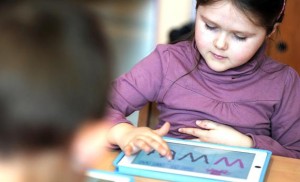
REALLY using iPads in the classroom
Personal mobile devices are the future and tablets are entering, perhaps pouring, into schools around the world. But as educators recognise their power as tools for teaching and learning across subject areas and years levels, it’s time to ask some questions – what are we using these devices FOR? Although the bloggersphere is packed full of ‘there’s an app for that’ lists and ‘101 iPad lesson ideas for your classroom’ pages, I’m certainly not the first to notice a gap in the dialogue. We need to have more conversations about the iPad’s purpose because all too often the iPad is being used in schools as what Alan November described as a ‘$1000 pencil’.
Tablets are a lot more than a portable screen. In fact, game-like apps, digital textbooks and the mobile ‘watching’ potential of the device are the very least of the value that the iPad can contribute to education. The focus should be on capturing teachable moments, reflecting on learning, producing original content and promoting deep engagement with problem-solving, invention and higher order thinking skills. As a teacher, I care most about what the students put into their technology, not what comes out of it. Creation.
For more, check out the iPad Art Room home page to see a collection of articles about teaching and learning with the iPad in Visual Art, and read this great piece from Lisa Guernsey for insight into a school using a 1:1 iPad classroom…the right way.
 FUTURE TENSE ” One morning I watched first-graders taking assessments of what they understood about “systems.” No pen-and-paper test was in sight. Instead, the teacher asked her students to come up with an example of a system and record a video of themselves explaining why their choice did, in fact, represent a system. A girl with a blond braid had drawn pictures of how people check out library books. With some technical guidance from the aide sitting next to her, and using an app called Explain Everything, she started arranging the pictures in a digital flow chart, adding arrows between her drawings of the book shelves, the checkout counter, the book at home, and the book being returned to the library. A few minutes later, she sat in a quiet corner by herself, pressed the record button, and explained each picture out loud. “My system is good,” she said at the end, “because if you don’t do something in my system, it will break down.”
FUTURE TENSE ” One morning I watched first-graders taking assessments of what they understood about “systems.” No pen-and-paper test was in sight. Instead, the teacher asked her students to come up with an example of a system and record a video of themselves explaining why their choice did, in fact, represent a system. A girl with a blond braid had drawn pictures of how people check out library books. With some technical guidance from the aide sitting next to her, and using an app called Explain Everything, she started arranging the pictures in a digital flow chart, adding arrows between her drawings of the book shelves, the checkout counter, the book at home, and the book being returned to the library. A few minutes later, she sat in a quiet corner by herself, pressed the record button, and explained each picture out loud. “My system is good,” she said at the end, “because if you don’t do something in my system, it will break down.”
Sam Ross, a second-grade teacher at ZIS, sees real potential in moments like this. “Children are being able to show what’s in their minds by adding the oral explanation,” he said. “That’s off-the-charts amazing.” Particularly helpful, he said, is to watch the recordings made by young children and English-language learners—students who may not speak up much in class but can actually show deep learning when asked to interview each other or record what they know. But most eye-opening, he said, is watching children have their own “aha” moments after watching recordings of themselves and talking to teachers about what they were thinking at the time.
At ZIS, every student has a blog or, in the case of younger children, a digital portfolio that teachers maintain. These portfolios allow teachers (as well as parents and students) to review specific work and rewatch moments that exemplify how the children have progressed over the year. One teacher showed me the blog of a fifth-grade girl who had recorded an assignment to show her knowledge of the parts of a plant. She did so by recording herself teaching a first-grader and answering the first-grader’s questions. In P.E., fourth-graders have recorded gymnastics routines so they can watch what they looked like and decide how to improve.
The iPad rollout, which began in earnest at the start of this school year, launched only after Mark Dilworth, director of education technology, consulted with teams of teachers in each grade to determine what they needed. Before students received their tablets, teachers experimented with video tools and chose appropriate apps. Every student’s device features the same apps—all downloaded by the information technology staff. Most of the apps on the iPads for the lower grades are aimed at creating and expressing ideas. In addition to Explain Everything, they include MyStory, iMovie, Animation HD, Google Earth, Book Creator, Show Me, Brushes, and Comic Life. They also feature Follett Reader and Overdrive, two subscription-based services to digital book collections.
This notion of using the iPad to make learning visible is not without hiccups, however—particularly when it comes to filming and editing. Despite all the talk about kids being “digital natives” who can navigate iPads before they can walk, teaching children to create videos isn’t easy. When I watched the first-graders complete their assessment on systems, one girl’s videos wouldn’t save at first—a technical problem that could have dissolved into a meltdown if a teacher had not been sitting right next to her to help. “It gave me gray hairs,” said a first-grade teacher about those first few weeks teaching iMovie to 6-year-olds. But she quickly added that the extra time was worth it. “
If you liked this post, check out the best bits of the iPad Art Room to see technology enhancing learning in the art classroom.
















I also get frustrated when I hear “the iPad (any device/tool) is all about consumption, not creation”… Would love to hear your thoughts…
OMG! Drives me crazy – there’s an app for that. There are apps, but the teacher is the key. Technology should be invisible link between tasks and the learning.